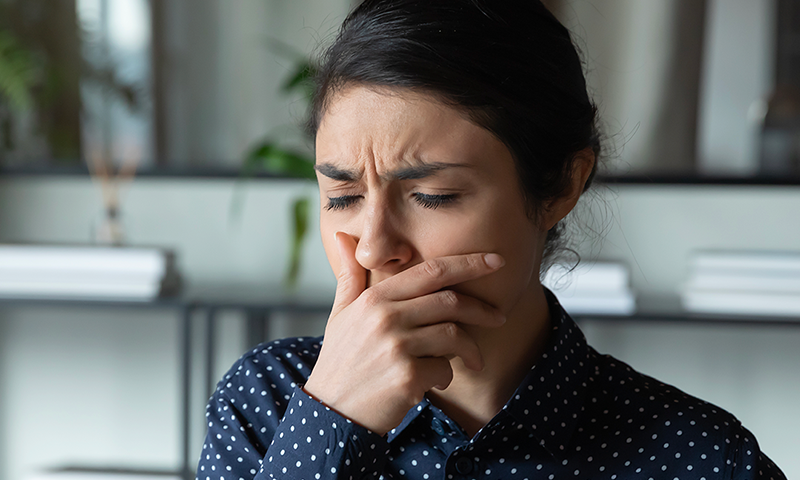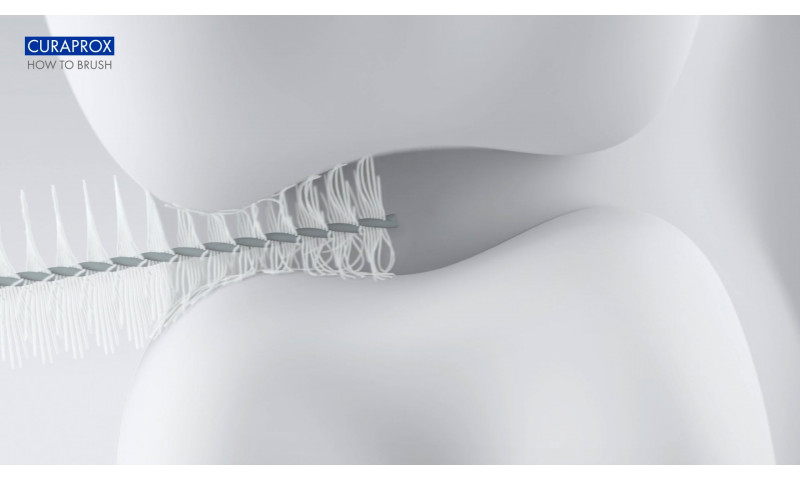Aphthae – what are they actually?
Aphthae – derived from the Greek verb haptō ("to set on fire") – are the most common type of oral lesions. They generally appear:
- On mucous membranes
- On or under the tongue
- On gums
One in ten people suffer from aphthae every now and then.
An inherent trait of aphthae is the painful sensation experienced, particularly when food and beverages come into contact with them. Brushing your teeth can also feel like torture. If these painful aphthous mouth ulcers recur after healing fully, they are referred to medically as benign oral aphthosis (BOA).
The four phases of the disorder
Aphthae usually develop in four stages:
- Prodromal stage: Sensation of tingling, tightness, burning and roughness as the initial symptoms.
- Macule stage: Inflamed, reddened, slightly raised area.
- Ulcer stage: The coating on the aphtha appears white.
- Healing stage: The infection starts to clear up.
What do aphthae look like?
Aphthae are usually round or oval white-yellowish sores that are red and swollen around the edge. Many people believe that the light-coloured coating is pus, but that is not true. It is in fact a film made of protein fibrin that forms a protective layer. It performs the same function as a scab on a skin surface cut. The size and thickness of the coating alters during the healing stage.
By the way: An aphtha does not usually bleed – only if the sufferer pokes, prods and pricks it. Aphthae can occur individually or in groups in the oral cavity.
Three different forms of aphtha
Oral aphthae can be divided into three forms, as presented below. For medical advice and information, however, you should always consult a health care professional.
Good to know:
Aphthae are not infectious. This also applies to herpetiform aphthae, which resemble herpes.
Why do aphthae develop?
Aphthae often appear out of nowhere – usually accompanied by sudden pain. But where do they come from? Most patients are unable to answer this question. And if the truth be told, the cause of the painful oral sores is still relatively unclear. Scientific research has, however, shown that in roughly 40 percent of the cases it is a condition that tends to run in families.
Even if the exact cause is not clear, there are several hypotheses regarding the factors that can trigger an outbreak. We have summarised them for you below.
Overview of possible factors
Small injuries
For example, if you accidentally bite your tongue or the inside of your cheek, health care professionals refer to this as a "minor trauma" – an injury that does not usually require treatment; quite often it is not even noticeable. These tiny injuries can also be caused, for example, by a fish bone or a hard piece of bread. Although they may appear harmless, they can lead to aphthae developing in your mouth.
By the way: Sometimes aphthae develop after a trip to the dentist's. During the course of a treatment or examination, minute and occasionally imperceptible injuries may also occur.
Hormonal fluctuations and stress
The hormones in your body can play a role in the development of oral aphthae. For example, monthly fluctuations in female hormone levels are also thought to contribute to the development of inflammation. Stress and the lack of sleep that often accompanies it also promote the emergence of small, painful sores inside your mouth.
Vitamin deficiency
Insufficient levels of iron, folic acid or vitamin B12 are considered potential contributing factors to the formation of aphthae. In the event of genuine vitamin deficiencies, it may be a good idea to use dietary supplements after seeking advice from a health care professional. Read more here.
Reflux
In rare cases, problems with your gastrointestinal tract can lead to aphthae appearing inside your mouth. Acid reflux – when stomach acid flows back up into your oesophagus – has been shown to contribute to the formation of aphthae but is not the actual cause. Again, it is best to consult a health care professional about whether there really is such a link.
Gluten intolerance
Coeliac disease – also known as gluten intolerance – has been identified as a possible factor in the development of oral aphthae. But again: Some people with coeliac disease may experience aphthae, while others never show any symptoms at all.
SLS (sodium lauryl sulphate) in toothpastes
SLS is a foaming and cleansing agent that is used in many household products, shampoos and shower gels. Due to its aggressive cleansing action, it is also ideal for cleaning garage floors or machines – and: is often added to toothpastes. SLS can dry out and irritate oral mucous membranes, enter the body and promote the formation of aphthae.
High histamine foods, spicy foods and condiments
Walnuts, hazelnuts, tomatoes and chocolate all contain histamine and are thought to promote the formation of aphthae, just like spicy foods and condiments. However, no one knows exactly why this happens.
Good to know:
SLS is not used as an ingredient in any Curaprox products. Take a look at our toothpastes in the shop!
Oral aphthae and COVID-19 – a link?
There is scientific evidence that a COVID-19 infection can change your oral mucous membranes. For a corresponding observational study, scientists evaluated 666 patients with COVID-19 in a hospital environment in Spain.
Of that group, 11.7 percent exhibited inflammation of the tongue's surface and the oral mucous membranes. Further symptoms included aphthae, as well as a white-coated tongue, aphthous oral infection and inflammation of the oral mucous membranes.
Do you want to learn how to treat aphthae? Then continue reading here.
Aphthae: Who is most at risk?
These tiny aphthous mouth ulcers usually occur between the ages of 20 and 30 years. Women are affected more often than men. Most people get an aphtha for the first time when they are a teenager or young adult.
On average, people who are prone to oral aphthae have to deal with these inflammations three to six times a year. While other people experience the sores only once every few years. As people grow older, the symptom-free phases last longer.
There are no specific risk groups – although it is known, for example, that people who stop smoking tend to develop aphthae, mostly in the first few weeks after kicking the habit. The inflammations typically heal on their own.
In general, it is important to know the possible triggers of aphthae – and to avoid them if you can.
Good to know:
Sometimes babies can also develop aphthae. This is usually referred to as Bednar's aphthae. It is caused by tiny lesions to the oral mucous membranes – usually on the hard palate of infants, for example when wiping their mouths. Bednar's aphthae generally appear in the shape of a butterfly or a circle. They usually clear up by themselves.
Treating aphthae: When should you consult a health care professional?
Most oral aphthae disappear completely after about one week and do not leave any scarring. If this is not the case and the inflammation is still red and swollen after two weeks, you should see a doctor to have the aphtha in your mouth treated.
Further reasons to be checked by a health care professional include:
- Enlarged lymph nodes
- Bad breath
- Fever
- Lethargy
- Joint and eye disorders
Needless to say, you should also see a doctor if you are concerned about the aphtha in your mouth and it is causing you a lot of problems.
Symptoms: What problems do aphthae cause?
Oral aphthae trigger various typical symptoms. In many cases, it starts with a tingling sensation and a red area. The inflammation may swell up a little and start to hurt. Within one to three days the swelling usually develops into the previously described whitish spot.
Although harmless, aphthae can severely reduce your quality of life. The chief reason for this is the severe pain. It can be so bad that it interferes with speech and eating. Luckily, the intense pain associated with the condition usually disappears after a few days.
Aphthae – how long does the pain last?
Anyone who has ever experienced an oral aphtha is bound to have asked this very question. Unfortunately, it is not possible to say when the pain will actually go away. Above all, it depends on what type of aphthae you are suffering from.
Behçet's disease: Aphthae as a sign of a serious illness?
It is not yet known why some people suffer from aphthae and others do not. It is different though if the aphthae are a sign of a serious illness. For instance, Behçet's disease – a very rare rheumatic disorder – could be the reason for the small oral sores.
The disease is characterised by small, painful oral and genital ulcerations. These small eruptions can vary in appearance, resembling either blisters or acne. Some affected people also have tender nodules (lumps) below the skin surface.
Individuals afflicted by these skin changes experience varying degrees of severity. While some individuals find these skin lesions mildly troublesome, others experience significant distress – particularly when the symptoms become more severe. Men are affected more often than women.
Symptoms often start in adults in their twenties and tend to be worse in men. Sometimes children can also be affected by Behçet's disease.
Good to know: Which health care professional should you see?
You feel unwell and are worried about your condition? Or your aphtha is getting bigger? Then you should go and see a doctor about it. In this case, it is advisable to consult either a general practitioner, a dentist or an ENT specialist.
An aphtha, yes or no? How to tell the difference between aphthae and other diseases
As a rule, it is quite easy to tell the difference between aphthae and other diseases in the oral cavity. Individuals with a tendency to develop aphthae are usually prepared for what awaits as soon as they notice the first tingling sensation.
Also, if you google "oral aphthae" or "mouth ulcers", there is no shortage of images to see. However, it goes without saying that these search results can be both worrying and confusing. Moreover, there are many diseases that resemble aphthae and are often confused with them.
To keep this from happening to you, we have compiled a list of the most important diseases that may resemble the symptoms of oral aphthae. But remember, for proper medical advice and information, you should always consult a health care professional.
Herpes
While certain herpes viruses have been identified in aphthae, it is important not to mistake aphthae for herpes. But what is the difference between aphthae and herpes? The key criterion: aphthae are not infectious. Herpes, on the other hand, can be spread very quickly by direct contact with the rash or even with an infected area without any visible blisters or sores. In addition, an outbreak of herpes can occur on the skin in or around the mouth, on the face or in the genital area – while aphthae form exclusively inside the mouth.
Dental fistulas
Many people ask: Do I have an oral aphtha or a dental fistula? Dental fistulas can bear a striking resemblance to oral aphthae, as they often exhibit a similar light-coloured coating. In the case of dental fistulas, however, this coating is not a protective layer, like with oral aphthae, but pus.
Dental fistulas only form on the gums and arise from an inflammation of the tooth root, the root tip or the tooth. Patients often feel a sensation of pressure or slight pain on or around the affected tooth. The gums may be fiery red.
Unlike aphthae, which are generally harmless, a dental fistula requires early treatment with antibiotics. In more severe cases, a diseased root tip must be removed or the tooth extracted. A small surgical procedure may also be necessary to lay open the fistula.
Fungal infection
Oral aphthae and fungal infections (oral candidiasis) are similar in that both form a white coating in the oral cavity and throat.
The main difference between the two conditions however is that fungal infections tend to achieve a blanket coverage of the infected area. Upon attempting to remove the coating, patients often discover underlying red and inflamed areas. Aphthae can also bleed sometimes.
Individuals afflicted with a fungal infection commonly report experiencing a furry sensation in their mouth, accompanied by a burning or painful tongue. This is due to yeast fungi that colonise the mucous membranes of the oral cavity. Another term for the fungal infection is "oral thrush".
Abscess
Basically, abscesses and oral aphthae do not have a lot in common – except for the fact that both hurt. An abscess is the localised accumulation of pus in a cavity formed from tissues. Abscesses are more dangerous than aphthae and require medical attention.
Oral cancer
Patients may have difficulty distinguishing between aphthae and oral cancer. If the discomfort lasts for more than two weeks or if you have any of the following symptoms, you should definitely see a doctor:
- Whitish or red blotches in your mouth.
- Sores in your mouth that bleed slightly or fail to heal.
- Swelling in your oral cavity.
- Sensation of a foreign body in your oral cavity.
- Loose teeth without any obvious dental problems.
- Difficulty chewing or swallowing.
Hand, foot and mouth disease
Hand, foot and mouth disease is common among children under the age of ten but can also affect adults – it occurs most commonly in the late summer and autumn. More than 80 percent of the people infected with the virus do not experience any symptoms at all. However, patients may complain of a fever, sore throat and loss of appetite.
The only resemblance to oral aphthae lies in the appearance of small red spots that can form on the oral mucous membranes, tongue or gums and which usually develop into painful blisters as the condition advances. However, these blotches can also appear on the palms of the hands, soles of the feet, buttocks, genitals, knees and elbows.
Aphthous oral infection (stomatitis)
Stomatitis is a generic term for a group of inflammatory diseases of the oral mucous membranes. One of the most common viral diseases is aphthous oral infection, which is caused by a herpes virus. It leads to numerous tiny blisters that resemble aphthae developing in the mouth.
Aphthous oral infection is highly contagious and painful. This disease mainly affects children under the age of four. And usually also results in a fever and swollen lymph nodes. Further character traits include extremely bad breath and an increased flow of saliva.
Tonsillitis
Both oral aphthae and swollen tonsils can hurt. However, it is usually quite easy to tell the difference between aphthae and tonsillitis. For instance, the pain you experience is very different. Tonsillitis typically causes a very sore throat and pain on swallowing and is often accompanied by a fever and a general feeling of illness. In contrast, aphthae only cause pain and discomfort in the area where they occur.
Another special characteristic of tonsillitis: white pus-filled spots on the tonsils, which are a typical sign of a bacterial infection. These generally need to be treated with antibiotics to clear the disorder.
Treating aphthae: Overview of possible therapies
You are desperate to get rid of your oral aphtha but they will not budge? In these cases, there are various medications available, but the focus is firmly on symptomatic therapy, as the causes of aphthae are still not fully clear.
Below is a general overview of possible treatment options. But as a general rule: If the symptoms are severe or keep coming back, you should definitely see a doctor.
Approved medications
In Germany, for example, the following drugs are approved for the treatment of aphthae:
Local anaesthetic drugs
They are usually the therapy of choice for treating aphthae. Drugs like Lidocaine, Benzocaine or Polidocanol offer clinically proven pain relief. Local anaesthetic drugs are available as creams, ointments, gels, lotions or lozenges.
Antiseptic drugs
Antiseptic drugs are chemical agents that destroy the germs that cause infectious diseases. These medications can be used as a mouthwash to relieve and treat oral aphtha pain.
Anti-inflammatory drugs
Anti-inflammatory drugs help decrease swelling and pain in a specific area.
Cortisone drugs
Cortisone drugs are the big guns when it comes to treating oral aphthae. They are the strongest anti-inflammatories and are usually only prescribed for patients suffering from severe inflammation. These products are not available to buy over the counter in pharmacies.
Which home remedies help to combat aphthae?
Do you suffer from uncomplicated oral aphthae every now and then and would like to try a home remedy before resorting to medication? Then take a look at our overview of common natural treatment options. Please keep in mind that there is no scientific evidence that these treatments actually work and their application can never replace a visit to the doctor.
Tea-tree oil
Tea-tree oil is a pure natural product extracted from the Australian tea tree. While the oil is often regarded as a universal remedy for infectious diseases, its efficacy does not align with the criteria set for clinical trials to establish drug effectiveness. Tea-tree oil is therefore not an approved medication.
If you want to try this home remedy, add a few drops of oil to a cotton swab and pat it gently directly on the aphtha. Prior to application, dab the aphtha and the surrounding area dry.
Aloe vera
Aloe vera is also said to have anti-inflammatory and healing properties. But as with tea-tree oil, the corresponding products are not approved medications. There is no scientific evidence to back up their effectiveness.
Do you still want to give it a go? Suitable gels are available over the counter in pharmacies. They can be applied directly to oral aphthae – but please always read the package leaflet carefully before use.
Sage and chamomile
Sage and camomile are also considered good home remedies for treating aphthae – but once again there is no scientific evidence to back up these claims. But the two herbs cannot do any harm, so maybe it is worth a try. You can, for example, use them to make a herbal infusion to rinse your mouth or gargle, as needed.
Salt water
Some people claim that salt water can be used to dry out oral aphthae. If you want to try this home remedy, simply dissolve one teaspoon of table salt in half a cup of warm water, ensuring to mix the solution thoroughly. Then rinse your mouth with it for roughly 30 seconds. Repeat the procedure every few hours.
Prevent aphthae developing in the first place: How to do it
Some people are more likely than others to develop aphthae. As pointed out, often there is little that can be done about this tendency. However, individuals who experience recurring and painful mouth ulcers can take certain precautions to avert the development of fresh inflammation.
We have summarised them below:
Pay attention to good oral hygiene
To ensure the mucous membranes that line your mouth are better able to fight off germs, they need to be healthy and strong. A good oral hygiene routine is essential to assure this. Since: If your oral cavity is clean and your teeth are healthy, there is less chance of bacteria, viruses and the like building up.
Brush your teeth at least twice a day and also use interdental brushes to stop aphthae in their tracks.
Avoid hard, acidic and salty foods
Certain foods can irritate sensitive oral mucous membranes. Therefore, as a precautionary measure, you can cut down on such foods. They include, for example, citrus fruits, hard bread crusts and crispbread or meals seasoned with pepper, paprika and curry.
Cut out alcohol and fizzy drinks
People who have a tendency to develop aphthae are encouraged to consume less alcohol and fizzy drinks. Since they can also irritate your oral mucous membranes and play a part in the development of aphthae.
Consider dietary supplements
Given that a deficiency in vitamin B12, iron or folic acid can contribute to the formation of oral aphthae, it might be wise to consider taking suitable supplements. Before taking this step, however, talk to a doctor to get advice on their correct and safe use.
Drink enough fluids
A dry mouth can contribute to the development of oral aphthae, as well as dental decay and gum disease. The best and easiest way to avoid this is to drink a sufficient amount of fluids.
And if you find normal still water too boring, why not try unsweetened herbal teas such as fennel or peppermint tea. Big fans of coffee can also breathe a sigh of relief. Coffee apparently helps to reduce inflammation and can therefore – in moderation – remain on your list.
Strengthen your immune system and mind
Oral aphthae are tiny infections that our body has to cope with. So, we should boost its response to help fight off infections. But this obviously requires a top fit immune system and healthy intestinal flora. Getting enough exercise and maintaining a well-balanced diet are essential for a strong and healthy body.
And remember: Mental health can also play a huge part in how diseases develop. Try to avoid too much stress in your life and boost your wellbeing – for example with a nice hobby or simple relaxation exercises such as yoga or progressive muscle relaxation.
Preventative tip: Keep a dietary diary
Keeping a dietary diary is a good way to identify which specific foods trigger or potentially promote the onset of aphthae. Make a note of what you ate and drank, and when, and also when the symptoms started. This might help you figure out which foods trigger your symptoms, allowing you to eliminate them from your diet in the future.
Sources
AWMF Leitlinien: Diagnostik und Therapieoptionen von Aphthen und aphthoiden Läsionen der Mund- und Rachenschleimhaut, updated: Currently under construction
Deutsches Ärzteblatt: Behandlung chronisch-rezidivierender oraler Aphthen, published online in 2014
Amboss (reference guide for health care professionals): Chronisch rezidivierende Aphthen, last update: 21.6.2022
Dr. Krause, Ute: Pschyrembel online (medical database): Bednarsche Aphthe, at: www.pschyrembel.de, last update: March 2023
Spektrum der Wissenschaft: Was tun gegen Aphten?, at: www.spektrum.de, updated: 11.12.2021
Wortbedeutung.info: https://www.wortbedeutung.info/Aphthen/
Dr. med. dent. Lukács, Dénes at Completdent Zahnklinik: Aphthen im Mundraum, at: www.completdent.de, updated: 20.12.2022
Gensthaler, Brigitte M.: Schmerzhafte Warnzeichen, at www.pharmazeutische-zeitung.de, edition 22.03.2017
Holz, Susanne: Wund im Mund: “Stress begünstigt Aphthen”, auf: www.tagblatt.ch, published on 23.09.2018
NDR: Aphthen behandeln und vorbeugen, at: www.ndr.de, updated: 06.02.2020
Pubmed: Are Oral Mucosal Changes a Sign of COVID-19? A Cross-Sectional Study at a Field Hospital, at: https://pubmed.ncbi.nlm.nih.gov/, updated: 27.02.2021
Kassenärztliche Vereinigung Baden-Württemberg: Neue wissenschaftliche Erkenntnisse: Mundschleimhautveränderungen bei Corona-Infektion, at: www.kzvbw.de, updated: 15.04.2021
German Federal Ministry of Health in cooperation with the Institute for Quality and Efficiency in Health Care (IQWiG): Aphthen, at: www.gesund.bund.de, updated: 28.08.2020
HNO-Ärzte im Netz with the Institute for Quality and Efficiency in Health Care (IQWiG): Aphthen: schmerzhafte Entzündung im Mund, at: www.hno-aerzte-im-netz.de, updated: 26.08.2019
Internisten im Netz: Was ist Herpes?, at: www.internisten-im-netz.de
Unterberger, Tanja: at Netdoktor: Zahnfistel, at: www.netdoktor.de, updated: 23.07.2021
Patienten-Information.de: Mundhöhlenkrebs – Risikofaktoren und Anzeichen, at: www.patienten-information.de
German Federal Centre for Health Education: Pilzinfektion der Mundhöhle (orale Candidose), at: www.gesundheitsinformation.de, updated: 02.04.2019
Infektionsschutz.de: Hand-Mund-Fuss-Krankheit, at: infektionsschutz.de, updated: 02.04.2019
MSD Manuals:
Hennessy, Bernard J.: Stomatitis, at: www.msdmanuals.com, updated: May 2020
Villa-Forte, Alexandra: Behçet-Syndrom, at: www.msdmanuals.com, May 2022
Thieme Verlag:
Stomatitis, at: www.viamedici.thieme.de, updated: 28.11.2022
Bednarsche Aphthen – Häufigkeit und beeinflussende Faktoren, at: www.thieme-connect.com, updated: 2006
Bork, Konrad, Burgdorf, Walter, Hoede, Nikolaus: Fachbuch “Mundschleimhaut- und Lippenkrankheiten”, at: https://books.google.de/, edition: 2008
University of Tübingen: M. Adamantiades-Behçet [ABD], at: www.medizin.uni-tuebingen.de, updated: unfortunately not legible
Müller, Celine: Was hilft bei Bläschen im Mund?, at: www.deutsche-apotheker-zeitung.de, updated: 14.12.2017
German Federal Institute for Risk Assessment (BfR): Verwendung von unverdünntem Teebaumöl als kosmetisches Mittel, at: www.bfr.bund.de, updated: 01.09.2003
Willke, Thomas: Aloe vera – Alles nur Werbung?, at: www.wissenschaft.de, updated: 21.03.2003
Halberstadt, Fee: Täglich Kaffee trinken: Neue Studie zeigt erstaunliche Wirkung auf die Gesundheit, at: www.hna.de, updated: 26.03.2022
Deutsches Krebsforschungszentrum and Bundeszahnärztekammer: Rauchen und Mundgesundheit, at: www.dkfz.de, updated: 2010
 Swiss premium oral care
Swiss premium oral care









